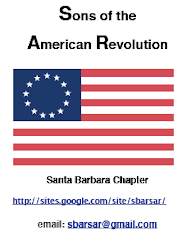The Star-Spangled Banner
by Dr. Roger McGrath
Nearly everyone knows “The Star-Spangled Banner” was written by Francis Scott Key, but usually that is about all anyone knows. Francis Scott Key was born in 1779 on the family estate in Maryland. His father was a lawyer and judge. At the time of Key’s birth his father was also an officer in the Continental Army. Key followed in his father’s footsteps and became a lawyer himself. His uncle was also a lawyer. That’s a lot of lawyers. It’s been said that America was founded by lawyers fleeing a just persecution.
Key first practiced law privately in Maryland but soon became the District Attorney for the District of Columbia. He was a competent and respected D.A., but were it not for the War of 1812 most Americans would never have heard of him.
When the British invaded Washington, D.C., they made their headquarters in Upper Marlboro, Maryland, seizing the estate of Dr. Williams Beanes and taking Beanes prisoner. Beanes was removed to a British ship in Chesapeake Bay where he was put to work treating wounded British officers.
Key happened to be friends with Beanes and asked President Madison if he, Key, could be authorized to negotiate with the British for a prisoner exchange and free Beanes. Madison authorized Key and provided a sloop to carry him, under a flag of truce, to the British ship holding Beanes.
The negotiations actually went smoothly and the British agreed to exchange Beanes for captured British officers. However, this was September 12 and early the next morning the British planned to attack Fort McHenry, which protected Baltimore Harbor. Since Beanes, and now Key, knew the strength and position of the British ships, the Americans would remain guests of the British until after the attack, an attack the British had every reason to believe would be successful.
Precisely at 6am on September 13 the British warships opened fire. The British ships were positioned about a mile and three quarters offshore from Fort McHenry. This was not by accident. The American cannons at Fort McHenry had a range of a mile and a half, while the British shipboard cannons had a range of two miles and their rockets a range of a mile and three quarters.
Francis Scott Key, temporarily a prisoner aboard the British ship, was a witness to the battle. All day long the British fired at Fort McHenry. When night fell, the battle became a pyrotechnic spectacle, especially the exploding rockets. Again and again the Stars & Stripes were illuminated in the darkness. All through the night the British continued the bombardment, anticipating that at any minute the American defenders would strike the colors and surrender the fort.
But when the sun rose the stout fort was still standing, damaged but undaunted, and high overhead the Stars & Stripes still flew proudly. Actually, this was a new, larger American flag that was raised in darkness just before dawn. The Americans were figuratively saying, “Here, you limeys, try this one on for size.” Francis Scott Key was overwhelmed with emotion by the sight. He recovered to report the still waving flag to American prisoners below decks.
The British were stunned. They were also out of ammunition. The British Naval commander ordered the fleet to withdraw.
An amateur poet, Key began to jot down lines of verse about what he had witnessed.
O say can you see by the dawn’s early light, What so proudly we hailed at the twilight’s last gleaming, Whose broad stripes and bright stars through the perilous fight, O’er the ramparts we watched, were so gallantly streaming? And the rockets’ red glare, the bombs bursting in air, Gave proof through the night that our flag was still there; O say does that star-spangled banner yet wave, O’er the land of the free and the home of the brave?
Most people don’t know that it is but the first of four stanzas. Anyone who can recite all four is a rare talent. Most people also don’t that Key wrote a poem, not a song, and that he titled his poem, “The Defense of Fort McHenry.” Key gave the poem to his brother-in-law, Joseph Nicholson, who was also a lawyer, and a judge as well. Nicholson thought the verse would fit well with the melody known as “To Anacreon in Heaven,” which celebrated an ancient Greek poet. Key’s poem may have fit but it required of singers a two-octave vocal range few could master.
At first, Key’s “The Defense of Fort McHenry” was published in newspapers as a poem only. It would be several weeks before the words and the music would be published together and the title changed to “The Star-Spangled Banner.”
Although the song became popular, it had no official status until 1889 when the Secretary of the Navy, Benjamin Tracy, ordered “The Star-Spangled Banner” played at naval flag raisings.
It began to be played at baseball games during the late 1890s.
In 1916, President Wilson ordered “The Star-Spangled Banner” played at military ceremonies.
Yet, America still had no national anthem. President Hoover changed that in 1931 when he made “The Star-Spangled Banner” our official national anthem. And, to think, it all started with a lawyer sitting on a ship in Chesapeake Bay chalking up billable hours.




